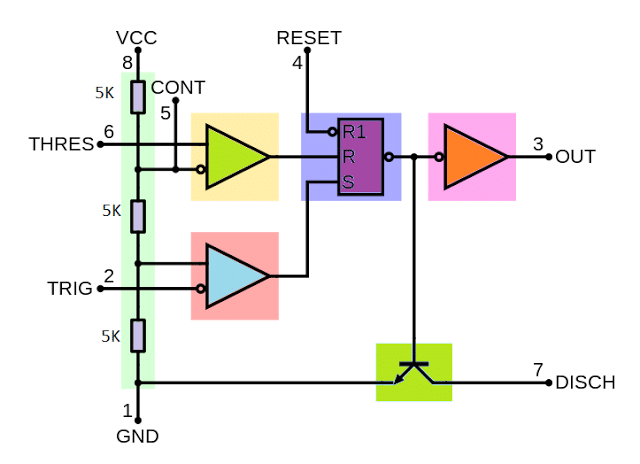In this post I have explained the how IC 555 works, its basic pinout working details and how to configure the IC in its standard or popular astable, bistable, and monostable circuit modes. The post also details the various formulas for calculating the IC 555 parameters.
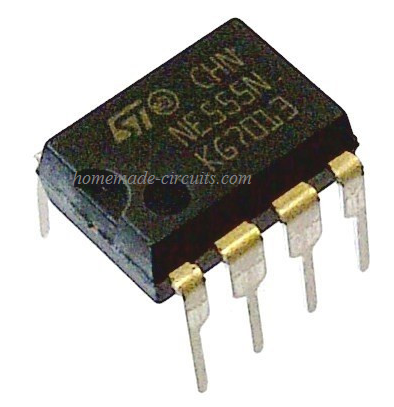
Introduction
Our hobby world would be less interesting without IC 555. It would be one of our first IC to use in electronics. In this article we are going to look back at history of IC555, their 3 operating modes and some of their specifications.
IC 555 was introduced in 1971 by a company called “Signetics”; it was designed by Hans R. Camenzind. It is estimated that about 1 billion IC 555s are manufactured every year. That’s one IC 555 for every 7 people in the world.
The Signetics Company is owned by Philips Semiconductor. If we look at the internal block diagram of IC 555 we find three 5K ohm resistors connected in series for deciding the timing factor, so probably that's how the device got its name IC 555 timer. However, some hypothesis claims that the selection of the name has no relation to the internal components of the IC, it was arbitrarily selected.
How IC 555 Works
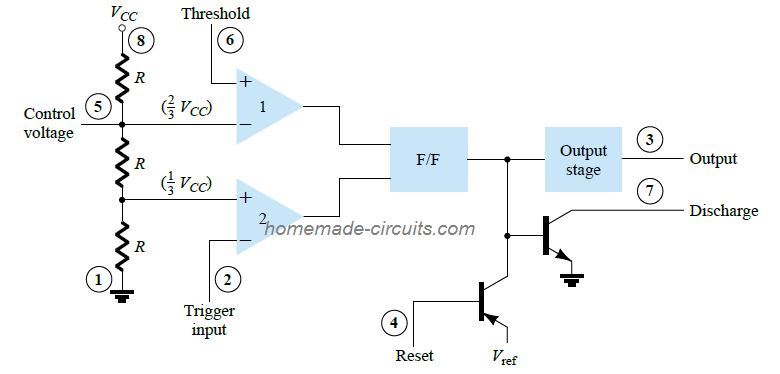
A standard IC555 consist of 25 transistors, 15 resistors and 2 diodes integrated on a silicon die. There are two versions of the IC available namely military and civilian grade 555 timer.
The NE555 is a civilian grade IC and has operating temperature range of 0 to +70 degree Celsius. The SE555 is military grade IC and has operating temperature range of -55 to +125 degree Celsius.
You will also find the CMOS version of timer known as 7555 and TLC555; these consume less power compared to standard 555 and operate less than 5V.
CMOS version timers consist of MOSFETs rather than bipolar transistor, which is efficient and consume less power.
IC 555 Pin Description and Working Details:
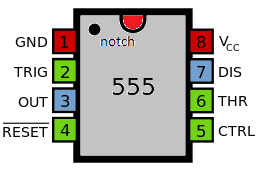
- Pin 1: Ground or 0V: It's the negative supply pin of the IC
- Pin 2: Trigger or input: A negative momentary trigger on this input pin causes the output pin3 to go HIGH. This happens by a quick discharging of the timing capacitor below the lower threshold level of 1/3rd supply voltage. The capacitor then slowly charges via the timing resistor, and when it rises above 2/3rd supply level, pin3 become LOW again. This ON/OFF switching is done by an internal FLIP-FLOP stage.
- Pin 3: Output: It's the output which responds to the input pins either by going high or low, or by oscillating ON/OFF
- Pin 4: Reset: It's the reset pin which is always connected to the positive supply for normal working of the IC. When grounded momentarily resets the IC output to its initial position, and if permanently connected to ground keeps the IC operations disabled.
- Pin 5: Control: An external variable DC potential can be applied on this pin to control or modulate the pin3 pulse width, and generate a controlled PWM.
- Pin 6: Threshold: This is the threshold pin which causes the output to go LOW (0V) as soon as the timing capacitor charge reaches the upper threshold of 2/3rd supply voltage.
- Pin 7: Discharge: This is the discharge pin controlled by the internal flip flop, which forces the timing capacitor to discharge as soon as it has reached the 2/3rd supply voltage threshold level.
- Pin 8: Vcc: It's the positive supply input between 5 V and 15 V.
Three Modes of IC 555:
- Bistable or Schmitt trigger
- Monostable or one shot
- Astable
Bistable Mode:
When the IC555 is configured in bistable mode it works as a basic flip-flop. In other words when the input trigger is given, it toggles the output stateON or OFF.
Normally #pin2 and #pin4 are connected to pull-up resistors in this mode of operation.
When the #pin2 is grounded for short duration, the output at #pin3 goes high; to reset the output, #pin4 is momentarily shorted to ground, and then the output goes low.
There is no need for a timing capacitor here, but connecting a capacitor (0.01uF to 0.1uF) across #pin5 and ground is recommended. #pin7 and #pin6 can be left unconnected in this configuration.
Here is a simple bistable circuit:
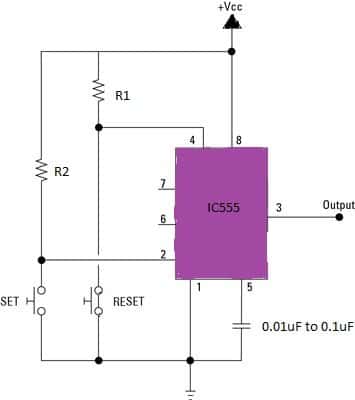
When the set button is depressed the output goes high and when reset button is depressed the output goes to low state. R1 and R2 may be 10k ohm, the capacitor may be anywhere between the specified value.
Monostable Mode:
Another useful application of the IC 555 timer is in the form of a one-shot or monostable multivibrator circuit, as shown in the figure below.
As soon as the input trigger signal becomes negative, the one-shot mode is activated, causing the output pin 3 to go high at the Vcc level. The time period of the output high condition can be calculated suing the formula:
- Thigh = 1.1 RAC
As seen in the figure, the negative edge of the input forces the comparator 2 to toggle the flip-flop. This action causes the output at pin 3 to go high.
Actually in this process the capacitor C is charged toward VCC via the resistor RA. While the capacitor charges, the output is held high at the Vcc level.
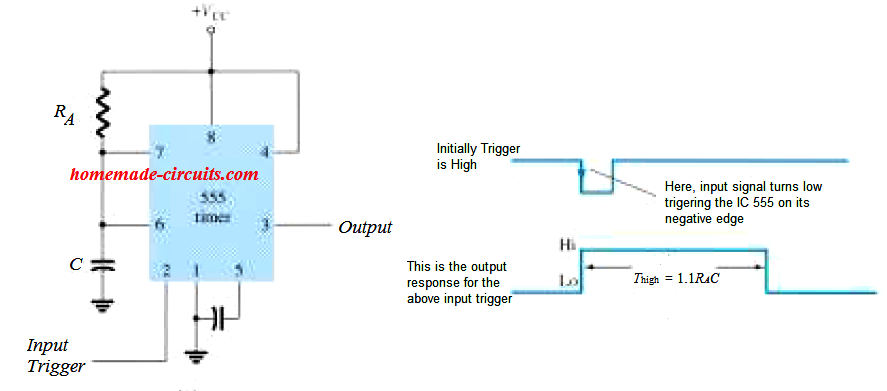
Video Demo
When the voltage across the capacitor acquires the threshold level of 2VCC/3, comparator 1 triggers the flip-flop, forcing the output to change state and go low.
This subsequently turns the discharge low, causing the capacitor to discharge and maintain at around 0 V until the next input trigger.
The figure above shows the entire procedure when the input is triggered low, leading to an output waveform for a monostable one shot action of the IC 555.
The timing of the output for this mode can range from microseconds to many seconds, allowing this operation to become ideally useful for a range of different applications.
Simplified Explanation for the Newbies
Monostable or one-shot pulse generators are widely used in many electronic applications, where a circuit needs to be switched ON for pre-determined time after a trigger. The output pulse width at #pin3 can be determined by using this simple formula:
- T = 1.1RC
Where
- T is the time in Seconds
- R is resistance in ohm
- C is capacitance in farads
The output pulse falls when the voltage across the capacitor equals to 2/3 of the Vcc. The input trigger between two pulses must be greater than RC time constant.
Here is a simple Monostable circuit:
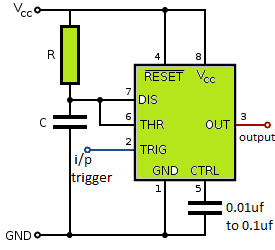
Solving a Practical Monostable Application
Find out the period of the output waveform for the circuit example shown below when it is triggered by a negative edge pulse.
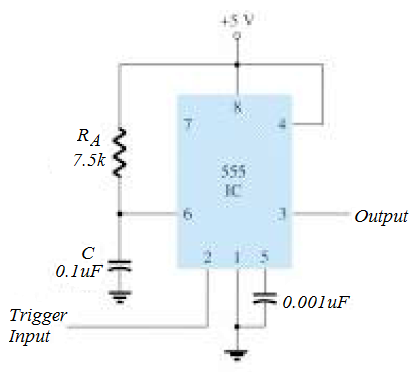
Solution:
- Thigh = 1.1 RAC = 1.1(7.5 x 103)(0.1 x 10-6) = 0.825 ms
How Astable Mode Works:
Referring to the IC555 astable circuit figure below, the Capacitor C is charged towards VCC level through the two resistors RA and RB. The capacitor is charged until it reaches above 2VCC/3. This voltage becomes the threshold voltage on pin 6 of the IC. This voltage operates comparator 1 to trigger the flip-flop, which causes the output at pin 3 to become low.
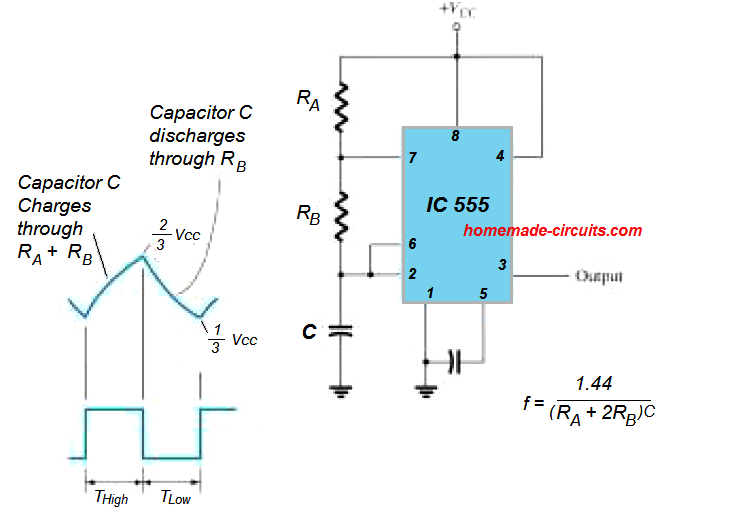
Along with this, the discharge transistor is switched ON, resulting in the pin 7 output discharging the capacitor via resistor RB.
This causes the voltage inside the capacitor to fall until finally it drops below the trigger level (VCC/3). This action instantly triggers the flip flop stage of the IC, causing the output of the IC to go become high, turning OFF the discharge transistor. This yet again enables the capacitor to get charged via resistors RA and RB toward VCC.
The time intervals which is responsible for turning the output high and low can be calculated using the relations
- Thigh ≈ 0.7(RA + RB)C
- Tlow ≈ 0.7 RBC
The total period is
- T = period = Thigh + Tlow
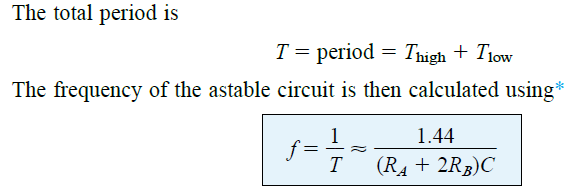

Video Tutorial
Simplified Explanation for the Newbies
This is the most commonly used multivibrator or AMV designs such as in oscillators, sirens, alarms, flashers etc, and this would be one of our first circuit implemented for IC 555 as a hobbyist (remember alternate blinker LED?).
When IC555 configured as astable multivibrator, it gives out continuous rectangular shaped pulses at #pin3.
The frequency and pulse width can be regulated by R1, R2 and C1.The R1 is connected between Vcc and discharge #pin7, R2 is connected between #pin7 and #pin2 and also #pin6. The #pin6 and #pin2 are shorted.
The capacitor is connected between #pin2 and ground.
The frequency for Astable multivibrator can be Calculated by using this formula:
- F = 1.44/[(R1+R2*2)*C1]
Where,
- F is the frequency in Hertz
- R1 and R2 is resistors in ohms
- C1 is capacitor in farads.
The high time for each pulse given by:
- High= 0.693(R1+R2)*C
Low time is given by:
- Low= 0.693*R2*C
All ‘R’ is in ohms and ‘C’ is in Farads.
Here is a basic astable multivibrator circuit:
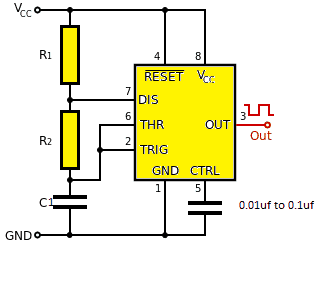
For 555 IC timers with bipolar transistors, R1 with low value must be avoided so that the output stays saturated near ground voltage during discharge process, else the ‘low time’ could be unreliable and we may see greater values for low time practically than calculated value.
Solving an Astable Example Problem
In the following figure find the frequency of the IC 555 and draw the output waveform results.
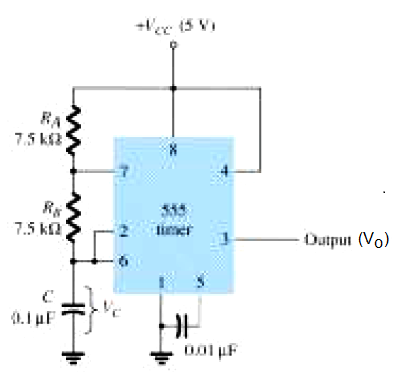
Solution:

Waveform images can be seen below:
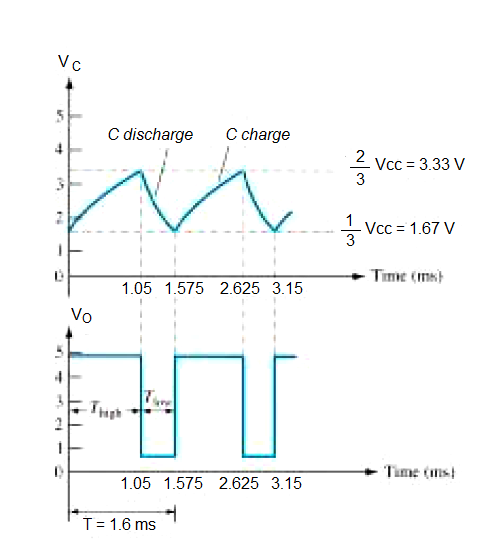
IC 555 PWM Circuit using Diodes
If you want the output less than 50% duty cycle i.e. shorter high time and longer low time, a diode can be connected across R2 with cathode on the capacitor side. It's also called the PWM mode for the 555 IC timer.
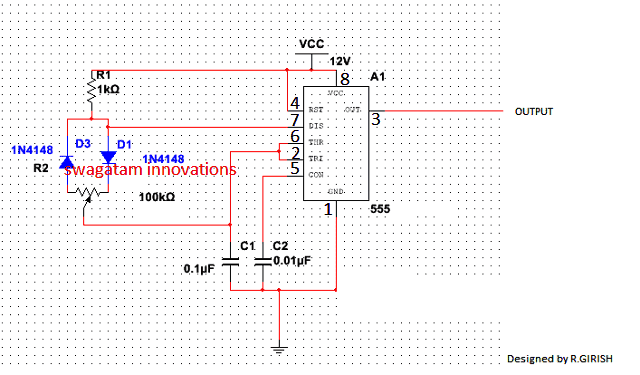
You can also design a 555 PWM circuit with variable duty cycle two diodes as shown in the above figure.
The PWM IC 555 circuit using two diodes is basically an astable circuit where the charge and discharge timing of the capacitor C1 is bifurcated through separate channels using diodes. This modification enables the user to adjust the ON/OFF periods of the IC separately, and therefore achieve the desired PWM rate quickly.
Calculating PWM
In a IC 555 circuit using two diodes, the formula for calculating the PWM rate can be achieved using the following formula:
Thigh ≈ 0.7(R1 + POT Resistance)C
Here, POT resistance refer to the potentiometer adjustment, and the resistance level of that particular side of the pot through which the capacitor C charges.
Let's say the pot is a 5 K pot, and it's adjusted at 60/40 level, producing resistance levels of 3 K and 2 K. Then depending on which portion of the resistance is charging the capacitor, the value could be used in the above formula.
If it's the 3 K side adjustment that is charging the capacitor, then the formula could be solved as:
Thigh ≈ 0.7(R1 + 3000 Ω) C
On the other hand, if it's 2 K that's on the charging side of the pot adjustment, then the formula may be solved as.
Thigh ≈ 0.7(R1 + 2000Ω) C
Please remember, in both cases the C will be in Farads. So you must first convert the microfarad value in your schematic into Farad, for getting a correct solution.
IC 555 Pulse Generator
This IC 555 circuit might seem recognizable to a lot of visitors because it is among the several versions of circuits from the common 555 timer circuits.
That does not essentially reduce its usefulness though. Simply because, a flexible pulse generator having a adjustable duty cycle can be a very handy equipment for any electronic workshop.
In contrast to the conventional 555 astable circuits that are generally implemented, the resistors between pins 6 and 7 includes P1, P2, R2, DI and D2.
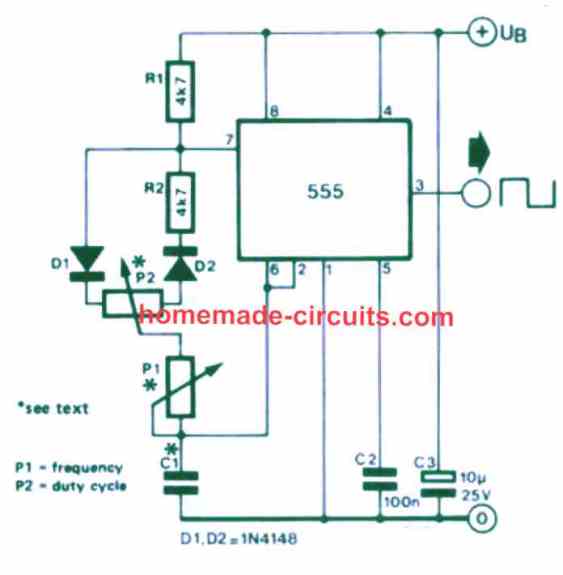
A tightly characterized charging time for capacitor C1 is established by the diodes D1 and D2.
This typically results in the duty cycle of around 50%, if it weren't for P2. For the present scenario the duty cycle is determined by the relationship between P1 and P2: n = 1 + P2/P1. For instance, if P2 = 0 (n = 100%), the frequency will then be:
f = 0.69 / [2(P1+P2+4.7kΩ)C1
References: Stackexchange
